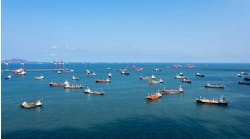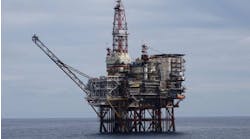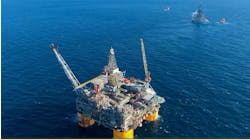US Gulf field designers are complaining that pipelines from ultra-deepwater projects will be incredibly expensive. FPSO units, such as Petrobras' Seillean are being used to produce from 1,853 ft water depths. The Seillean will be used temporarily on the Roncador project off Brazil, starting in December. Seillean will produce up to 20,000 b/d of oil from two wells for about a year.
Floaters needed, since deepwater pipelines are crippling expense
There are at this time no mobile floating production systems inthe US Gulf of Mexico, although studies are underway. Chris Oynes, regional director of the US Minerals Management Service, said that an environmental impact statement study regarding the use of floating production, storage, and offloading vessels (FPSOs) in the US Gulf of Mexico was well underway.
Speaking at the Deep Offshore Technology Conference (DOT'98) in New Orleans, Oynes said the study, which is funded by the MMS and DeepStar, may be complete by August of 2000. Aker Engineering manager of naval architecture Richard D'Souza said pipelines from deepwater projects represent a "crippling expense." D'Souza envisions deepwater use of FPSOs in the Gulf in 3-5 years.
The industry worldwide is considering installing 135 floating production systems over the next five years, compared with 75 in the previous period. This assessment, by analysts Douglas-Westwood Associates, points out that 89 oil companies are considering field developments involving floaters. John Westwood said, "The leader of the pack is Petrobras with 27 prospects, but virtually all the majors have significant numbers planned." He said that over the next 5 years, he expects that 90% of the world's deepwater capex will be associated with floating production systems. "However," he added, "it must be stressed that there are at least 82 prospects for FPSs in water depths less than 250 meters."
Petroport storage project moves forward
Blue Dolphin Energy said engineering and commercial evaluation of its Petroport project has been completed. Petroport will incorporate subsea salt caverns for the storage of crude oil and refined products to be delivered by tanker and stored or piped to shore. To be located 45 miles off Freeport, Texas, in 120 ft of water, the offshore port facility will allow two vessels to offload simultaneously into the caverns.Initially, six caverns with a total capacity of 30 million bbl will be constructed. As facility throughput grows, the four caverns can be enlarged by as much as 24 million bbl. Also, for longer term storage, additional caverns may be constructed, giving shippers the option of leaving some or all of a cargo in storage for a short or extended period. Crude oil can be delivered by 42-in. pipeline to shore, with access to the major Texas and mid-continent refining centers. A possible future use for Petroport, if the market demands, is as a hub for deepwater projects on the OCS - the design incorporates receipt of two pipelines to the tune of 250,000 b/d.
The next phase of the project includes site evaluation and the licensing of the facility by federal and state authorities. Blue Dolphin is in discussions with possible future partners, but will retain operatorship of the proposed facility. The planned timetable, though obviously subject to change, is as follows: submission of license application to the Department of Transportation by mid-1999; call for construction bids by May or June 2000 if license bid appears successful; license grant by September 2000; two years fabrication work; and finally, startup of the facility by 2002.
E&P Briefs
- Titan Offshore's well No. 1 on Vermilion 253 was drilled to TVD of 11,270 ft. Preliminary log calculations indicate 900 ft of oil and gas pay in 18 sands. Titan and partner Seneca Resources (50%) are evaluating the reservoir with salt proximity studies, 3D seismic, and additional drilling on the block.
- A well drilled in the North Marlin Prospect on Viosca Knoll 827 penetrated a pay zone in the Middle Miocene section at 11,500 ft. It found a 135 ft gross hydrocarbon-bearing interval in laminated turbidite sands similar to the nearby gas reservoirs in Tahoe Field. The well, located in 2,521 ft of water about 135 miles southeast of New Orleans, is operated by Shell Deepwater; CNG holds 35%; and Murphy Exploration & Production holds the remaining 30%.
- Ship Shoal 241 A-2 well found 76 ft of net pay and is now producing 19.6 MMcf/d of gas and 83 b/d of oil from perforations at 6,626-6,670 ft. Bellwether Exploration holds 11.5% working interest in this well.
- Basin Exploration said it placed onstream the No. 2 well on East Cameron 34 and the No. 20, No. 21 and No. 22 wells on West Cameron 45. Basin operates both properties. Gross production from the well on East Cameron 34 has increased to a sustained rate of 9.5 MMcf/d of gas and 100 b/d of condensate. Four separate completions in the three wells on West Cameron 45 were placed online at various times. Aggregate gross production from these intervals, which hasn't yet been stabilized, has reached levels of approximately 20 MMcf/d of gas and 100 b/d of condensate. Production from a fifth completion, which was previously tested at rates up to 6.4 MMcf/d of gas and 100 b/d of condensate, is expected to be added this month.
Copyright 1999 Oil & Gas Journal. All Rights Reserved.



